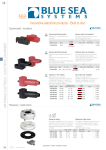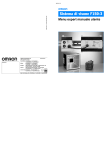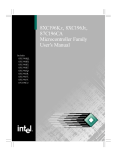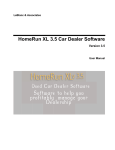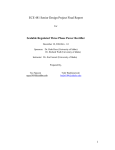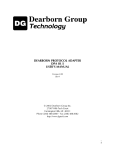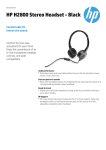Download Report on CAN Train Controls - Electrical and Computer Engineering
Transcript
Technical Description of the TRAIN CONTROL NETWORK January 14, 1997 Richard W. Wall University of Idaho Department of Electrical Engineering I. area. Only the information itself is identified by a 28 bit word unique to each message type. The message types specified in SAE standard J1939 assign variables to each data byte in the message data filed. Message data lengths are from zero to eight bytes. The are three instances that initiate network traffic; unsolicited, request for data, and response to request for data. The unsolicited messages are initiated for system exceptions and by the server controller as control messages. The server unit request new data on timed intervals by sending an abbreviated message that contains the message identifier and a single bit that signals other units on the network that this is a request for data. Units with this information immediately respond with the appropriate data message. All network arbitration and error management is handled by the CAN controller IC’s either the Intel 82527 or the 87C196CA internal CAN controller. Each CAN transmission uses bit stuffing for synchronization, 16 bit CRC for error checking, and message prioritization for collision avoidance. GENERAL HARDWARE OVERVIEW Eight processor boards make up the Controller Area Network (CAN); six of which are based on the i80C196CA processor and two on the i87C196KD processor. Software on one i87C196KD processor board control the DC bus voltage while the other simulates the track load by controlling the load motors. The program contained on the i87C196CA evaluation board supports three classes of applications programs; the server Controller, Inverter Controller, and the Dynamic Brake Controller. All processor boards have an RS232C serial interface operating at 38.2KB and a CAN interface using the RS485 physical layer. The applications on the i87C196CA boards are selected by settings on the eight position DIP switch. Two sets of DIP LED modules on the i87C196CA boards provide status information. LED 1 cycles in acknowledgment of accepting a CAN control or status message. LED 2 blinks two elements that identifies the fact that an application program is currently running and another led that identifies which particular application program is executing. The i87C196CA processor boards are produced by Dearborn Group in Dearborn, MI. The systems are supplied with Intel RISM (Reduced Instruction Set Monitor) ROMS and were used while the application programs were under development. There are two possible ways to interface to the CAN using the 87C196CA evaluation boards; by the external i87527 CAN controller IC on the PCB or the internal CAN controller within the 80C196CA processor itself. The i87C196KD processor boards is produced by Intel and also supplied with a RISM ROM base monitor. These processor boards interface with the CAN using an i87527 CAN evaluation board (See appendix B). After development, the RISM Monitor ROMS, U16 and U17, were replace with application ROMS programmed with specific code. The address decoding GAL22V10, IC5, on the 87C196CA boards and IC12 on the 87C196KD boards are modified to permit the system to operate without a host CPU. The applications code was developed using IAR ICC196 version 5.1 and Codeview IDE from Chip Tools,. Inc. The i87C196KD processor boards have the RS232 serial drivers on the evaluation boards where as the i87C196CA boards do not. For the later processor boards, the RS232C drivers are located on an external driver board designed by the University of Idaho. Each 87C196 processor board and RS232 driver board requires 500ma maximum current at 5 VDC. The CAN - RS485 serial bus requires a DB9 male connector to interface to the 87C196CA board. III. UNIT IDENTIFICATION Six control units use the 87C196CA processor boards. All six of these units have the identical microprocessor code. The boards are set for the particular application by selecting one of the six S1 DIP switch settings shown in Figure 1. The switch setting can be set before power is applied and the processor will start in the corresponding applications mode. The DIP switch settings are only read in the power up initialization routine. If the switches are modified while the processor is running, the unit must be reset, either by a power down power up sequence or by pressing the reset push button, S2, on the processor board. A reset is signaled on the processor board by all LED’s on LED1 and LED2 flashing three times. II. CAN MESSAGE STRUCTURE ON 1 ON 1 ON 1 2 3 4 5 6 7 8 2 3 4 5 6 7 8 2 3 4 5 6 7 8 S1 S1 S1 Master Traction Motor #1 Traction Motor #2 ON 1 2 3 4 5 ON 1 2 3 4 5 ON 1 2 3 4 5 6 7 8 6 7 8 6 7 8 S1 S1 S1 Flywheel #1 Flywheel #2 Dynamic Brake Figure 1. 87C196CA processor board DIP switch settings The CAN uses a message based communications scheme that requires no network management resources or time when nodes enter or exit the network. The primary information identification comes from a message ID and does not identify either the source or the destination of the message except by specific design using fields allocated inside the message data DIP position 7 of S1 controls the “NO ACTIVITY” automatic reset function. If no commands have been received from network communications for a period of five seconds. the unit executes a power up reset. During the reset, the control outputs default to the safe-fail mode and the network is re- 2 initialized to attempt to re-establish communications with the server unit. LED indication lights are packaged on two separate LED clusters each holding eight individual LEDs. During normal operations, the eight individual LED lights on the LED1 cluster will sequence in a ring counter fashion. For I/O processor units, the LED’s stop sequencing should network commands cease. LED number eight on the LED2 cluster flashes at a 4 second rate to signal that the processor is operating. A second LED on cluster LED2 flashes on at a two second rate. The particular LED that flashes corresponds to the unit identifier set on S1 as shown in Figure 1. range of 0 to 1000 although it will be nominally set for 800VDC. Table I. Server to PC data format Digit 1 2 3 4 5 6 7 8 9 10 11 12 13 IV. NETWORK OPERATION Although CAN accommodates peer-to-peer network communications, this implementation currently has the server unit managing the network information. Once each second the server unit requests updated information of all parameters from other units on the network. This updated information is communicated with the supervisory PC over a 38.4KB RS232 serial channel. Although using ASCII text characters requires greater communications time than sending the information as binary data, ASCII allows data to be qualified quite easily and is very beneficial during development phases. The PC is expected to operate on this information and generate new commands in a timely manner. When the new commands are received by the server unit, the information is disseminated over the network as specific messages to be implemented at remote locations. If there is no response from the supervisory PC with in one second, no commands are sent out on the network. Any i80C196CA board can be set to be the server unit by setting all eight DIP switches on S1 to off and pressing the reset button on the board. Under normal operation, both LED units will flash on three times during initialization. Before beginning operation, a the following text string is sent out the RS232 port: “%Supervisory system on line”. A carriagereturn / linefeed (CR-LF) sequence is sent before and after the message. While running in the server mode, the serial communications to the supervisory PC contains 14 space delimited values using the format shown in Table I. The serial string is always 69 characters long including the terminating CR-LF sequence. All values are four decimal digit with leading zero suppression except for the eleventh value which is a single decimal digit. The serial communications operates at 38.4KB, eight data bits, no parity, and one stop bit. Table II describes the messages from the supervisory PC to the server controller. Six control variables are passed manage the energy production, use and storage for the train. To reduce communications overhead, only positive variables are passed. Present convention uses a range of zero to 2000 as nominal control parameters. This represents -100.0% to +999.9% for all converter controls. The DC bus voltage has a 14 Parameter Traction Motor #1 Torque Traction Motor #1 Speed Traction Motor #2 Torque Traction Motor #2 Speed Flywheel #1 Torque Flywheel #1 Speed Flywheel #2 Torque Flywheel #2 Speed DC BUS Volts DC BUS Amps Dynamic Brake Control Train Speed Train Distance modulo 10K feet Train Distance / 10K feet Range Min Max 0 2000 0 2000 0 2000 0 2000 0 2000 0 2000 0 2000 0 2000 0 2000 0 2000 0 1 0 255 0 9999 0 9999 Table II. PC to server data format Digit 1 2 3 4 5 6 Parameter Traction Motor #1 Power Traction Motor #1 Speed Traction Motor #2 Power Traction Motor #2 Speed DC Bus Voltage Brake control Range Min Max 0 0 0 0 0 0 2000 2000 2000 2000 1000 1 The server unit is configured to receive eight different CAN messages with each message containing eight bytes of data. Figure 2 illustrates the network configuration and the message routing. Messages from the server to I/O nodes are either “request for status data” or “command” messages. Messages form the I/O units are all “status” messages in response to the “request for status data”. Six units receive “commands” from the server unit; the two Traction Converter control units, the two Flywheel Converter control units, the Dynamic Brake control unit, and the DC bus voltage control unit. The track position and train velocity data is provided by the Track Simulator unit. Table III. describes the message content for each of the message type used in the system. As the bi-directional arrows in Figure 2 imply, control messages and status messages between a given unit use the same message number. For example, if the server unit needs an update from the Traction Motor #1 unit, a “request for data” is made on the network for message number 32769. Traction motor #1 unit then responds with it’s data using message number 32769. When the server unit issues a command to Traction Motor #1 unit, it does so using the same 32769 message number. Another unit monitoring network traffic that in set to receive message 32769 would be able to distinguish the command data from the status data since the different information occupies different fields in the message structure as Table III describes. The CMD- STATUS column indicate the information source. As stated above, the source of command information (C) is the server 3 unit while status information (S) is generated by I/O units. Message data with unidentified sources are not used in this implementation. Although the server unit controls the network traffic in a master-slave fashion, peer-to-peer and unsolicited slave to server communications is not precluded by hardware or software. Figure 3 shows the order of communications for the network traffic as well as typical information timing. This timing is specifically for the system designed for RS232C serial communication between the server and the supervisory PC operating at 38.4KB and the CAN operating at 74KB. The delay between the status update to the supervisory PC and new command data from the PC maybe as long as 150ms depending upon PC activities and complexity of the Matlab algorithm running at that time. Figure 4 shows the effects of an I/O processor missing from the network. The server waits up to four milliseconds for after a request for message update before continuing on to the next update request. Figure 5 and Figure 6 shows the CAN message timing during request for updates in greater detail. From these figures, the overhead associated with requesting message updates can be determined. IBM Compatible DC Bus Controller Track Simulator 65271 32771 Server Unit Flywheel #2 Controller 32772 Flywheel #1 Controller 65256 Traction Motor #1 Controller 65274 32769 32770 CAN Network 65248 Traction Motor #2 Controller Dynamic Brake Controller Figure 2. FRA Network information traffic routing Table III. Network message data formats Number Message Bit Message name Posidata tion 32769 -72 Inverter Torque Control Bit 0 Bit 1 Bits 2-3 Bits 4-5 Bits 6-7 65248 Train Distance Bits 0-3 Bits 4-7 65256 65271 Train Speed Train Electrical Direction Ground Speed Track Pitch Track Altitude Bits 0-1 Bits 2-3 DC Bus Amps Alternator Current Alternator Volts Bus Volts Bits 6-7 Dynamic Brakes Trip distance feet Total Distance - feet Bits 0-1 Bits 2-3 Bits 4-5 Bits 6-7 Bits 4-5 65274 Dest. Unit Source Unit Unit speed Commanded Power Unit Torque Bit 0 Bit 1 Bit 2 Bits 3-7 Brake Application Brake Pressure #1 CMD Status Data Type S C Byte Byte Word Word S Word S Long Figure 3. Message timing for normal operations Long S Word Word Word Word S Word Word C Word S Word CS Byt e Brake Pressure #2 Byt e Byt e Unused NA Figure 4. Message timing for no response from Flywheel #2 4 Server RTOS Allocate silicon based resources Foreground token management Parse String New line ready Yes Control setpoint update Serial Rx ISR No Send network commands Figure 5. CAN status update message Yes Network message decoded CAN Rx message Control status update No Serial Tx Poll network for control status update CAN Rx message Yes Timer ISR No Foreground token management Figure 7. server RTOS software flow control Figure 6. CAN status message update with no response from Flywheel #2 unit Timer ISR V. SERVER OPERATIONS Software Time Interrupt Figures 5 through 1 describe the control flow for the server RTOS software. Three token generating events determine the activity within the RTOS; an internal software timer, a CAN message received, and a new line of serial input. Time-out timers in application processes guarantee that no process waits for an unanswered request for action or information from any internal or external process. The RTOS loop must be executed every 15 ms or an internal Watchdog Timer resets the microprocessor. During the reset (regardless of how the reset is initiated) resets all control variables an distributes this initialized information throughout the network. A ‘No Activity’ flag resets the processor should no messages be received from the supervisory PC within five seconds. The process called ‘Control Status Update’ in Figure 7 actually consist of a series of request for transmission on the CAN to update the status data base maintained in the server processor. This information is posted by the various I/O nodes in a timely manner such that no information is older than 20ms when the status information is sent to the supervisory PC. I/O processors transmit data on the CAN only when requested or a control exception is detected by the I/O processor. Decrement Time-out Timers Decrement NO Activity Timer Activity in last 5 Sec? No Halt program without Watchdog timer update Yes Return to process in progress Hardware reset Figure 8. Timer event generator and 'No Activity' monitor 5 VI. INVERTER CONTROL OPERATIONS CAN IO Received CAN Message ISR Request CAN Message ISR Qualify message Qualify message Decode Message Identifier Encode Message Identifier Update Control Status Buffers Set CAN Rx Token Post CAN Message Send CAN Message Encode Message Identifier Encode Message Identifier Invallidate Message Invallidate Message Set CAN control for TX Reqest Move control data to CAN message area Move control data to CAN message area Process complete Set CAN control for new data Set CAN control for new data Vallidate Message Vallidate Message Process complete Process complete The operations of the inverter control processors except for the message ID number used for passing control and status information. Figure 11 describes the control flow for the inverter unit RTOS software. The support routines are identical to Figures 8 through 10 implemented in the server unit. This feature makes efficient code development and maintenance. There are two events that cause an updated CAN message to be posted; New information received from the serial input and the expiration of a 10ms timer. The inverter DSP units are programmed to automatically reply the torque and shaft angular velocity data after receiving a command. Hence, when a timer generated command is sent, the status information is also updated because of this action. The four inverter control messages (message ID 32769 through 32772) have five fields as shown in Table II. The Destination and Source Node ID fields are a reference to previous generations of network code and are no longer actively used for present implementations. Information for the “Commanded Power’ field is supplied by the server unit using a data base maintained locally on the server unit. Before the control message is sent, data last received from the inverter controller is filled into the appropriate fields in the message. This data base is maintained by communications with the supervisory PC. Inverter - CAN interface units supply the data for the unit torque and unit speed using an 38.4KB RS232 interface. Inverter power data received from the server is filled into the CAN message before being sent by the inverter-CAN interface units. This in effect makes complete information messages regardless of the source node and allows convenient monitoring by an independent processor connected to the network, Specifically, the 80C196CA unit sends the inverter DSP unit a ASCII decimal number in the range of 0 to 2000 which the inverted DSP interprets as -100.0% to +99.9%. This string is terminated with a conventional ASCII line-feed and a carriage-return (0DH and 0AH). Since the MCS96 Evaluation PCB does not support an RS232C serial port directly, a Serial Interface and I/O Driver board was developed by the University of Idaho for this purpose. The schematic diagram of this PCB is shown in the appendix as Figure 15. Figure 9. CAN message control SERIAL IO Serial Output (printf - putch -puts) Serial Input (gets - getch - new line) Yes Buffer full? Serial Input ISR No Load transmit ring buffer Initiate Tx ISR Initiate Tx ISR Yes Char == \n or \r? No VII. BRAKE CONTROLLER Load receive ring buffer The RTOS software flow control described by Figure 12 uses support routines identical to those shown in Figures 8 through 10 as implemented in the server unit. The main difference between the this 80C106CA application code and those discussed above is that the I/O is directly implemented on the microprocessor board using the add-on serial interface and I/O driver board shown in the appendix as Figure 2. The I/O driver circuit has been modified to allow the digital tachometer to monitor an auxiliary contact on the brake unit for brake position status. The microprocessor unit is pro- Return to RTOS process manager Figure 10. Serial IO control 6 INVERTER CONTROL RTOS grammed to output the digital value over both the CAN and the RS232C serial channel when a new position is detected; a ‘1’ if the brake is energized and ‘0’ if not.. Under normal operation, the brake commands are supplied via a network messages but for test purposes, the brake commands can also be set using the RS232 serial interface. Entering a ‘1’ followed by a return will cause the brake to be energized and a ‘0’ will disengage the brake. Allocate silicon based resources Foreground token management Parse String New line ready Yes Post network message No CAN Rx message YES Serial Tx control data VIII. DC BUS VOLTAGE CONTROLLER As stated above, this controller is implemented using an Intel i87C196KD processor. Appendix B describes the process of interfacing this processor or, more specifically, the i87C196KD Evaluation board to the i82527 CAN evaluation board. Since the processors belong to the same family of micro controllers, significant code developed for the i87C196CA applications was leveraged for the i87C196KD programs. Namely the CAN management programs were useable with only minor modifications which dealt with the CAN processor reset and the physical mapped memory addressing. The closed loop algorithm uses conventional digital PI control. The voltage set point is supplied by the supervisory PC via the CAN. The on-chip 10 bit AD converter digitizes the DC bus voltage and DC bus current transducers signals which are needed for closed loop control and system status. Figure 13 shows that process control loop the DC bus controller includes an LCD display of instrumentation and control variables. The LCD is updated once for every 15 AD conversion complete interrupts. During the AD complete ISR, the PI algorithm is executed and the instrumentation data is posted to the CAN controller. The PI algorithm uses a 10 ms sample rate by scheduling the PTS (Peripheral Transaction Server) to burst convert two AD channels. At the end of the burst cycle, the i87C196KD is interrupted to begin processing the AD complete ISR. Figure 16 in Appendix I shows the schematic diagram for the IO driver and LCD interface board. Serial Rx ISR Network message decoded No CAN Rx message YES Timer ISR Serial Tx control data No Post network message Foreground token management Figure 11. Inverter control RTOS flow diagram DYNAMIC BRAKECONTROL RTOS Allocate silicon based resources Foreground token management Parse String Post network message YES Yes New line ready Serial Rx ISR No CAN Rx message Network message decoded Set digital output Read digital input No Serial Tx control data YES CAN Rx message Timer ISR Set digital output Read digital input No Post network message Foreground token management Figure 12. Brake controller RTOS flow diagram 7 Figure 13. DC bus control and instrumentation unit flow diagram DC BUS VOLTAGE CONTROLLER Allocate silicon based resources Foreground token management Compute new control output Yes Post instrumented data to CAN PID Loop Control AD Complete ISR No Schedule next AD sample Update LCD and reset loop counter Yes AD loop counter AD Complete Flag No Register VDC Set Point Relay VDC S.P., VDC Inst., & IDC Inst. to RS232 port Yes CAN Rx message Network message decoded No Send RS232C Serial Data Foreground token management 8 TRACK-LOAD SIMULATOR Allocate silicon based resources Foreground token management Determine Speed and Distance Traveled Yes Simulator algorithm AD Complete ISR Determine Load torque No Post instrumented data to CAN Schedule next AD sample Update LCD and reset loop counter Yes AD loop counter AD Complete Flag Register VDC Set Point Relay speed and distance data to RS232 port No Send RS232C Serial Data Foreground token management Figure 14. Track-Load simulator flow diagram 9 Appendix I Driver and Interface Board Schematic Diagrams Figure 15. 87C196CA I/0 auxiliary driver board schematic diagram 10 Figure 16. 87C196CA I/0 auxiliary driver board schematic diagram for brake control 11 Figure 16 Schematic diagram of auxiliary IO driver for the 87C196KD processors 12 Appendix II Notes on Interfacing the Intel 82527 CAN controller satellite board to the 87C196KD-20 Evaluation Board A.II.I. Introduction The following discussion addresses issues interfacing the Intel CAN controller satellite board with a 87C196KD-20 Evaluation board. It was determined through research and experimentation that some hardware modifications are necessary. These modifications are concentrated in three areas. The 60 pin DIN connector, JP3, the addressing mapping PAL, U12, and the 87C196KD crystal, X1. No modifications of the 82527 CAN satellite board were necessary but jumper settings must be set for 8 bit standard Intel data transfers. Code has been developed using ICC196 by IAR Systems[1] C compiler version 5.10 and 80196 assembler. This code was loaded onto the 80C196 Evaluation board Rev. 3.1 running KBRISM Rev.1.2[2] using Chip-View 196 version 1.33 by ChipTools[3]. The EV82527 Rev. 1.1 evaluation CAN satellite board is available from Dearborn Group[4]. Reference manuals the evaluation boards[5,6,7] were needed to design and trouble shoot hardware modifications. A.II.II. EV80C196KD-20 JP3 Modifications Interfacing the two evaluation boards is accomplished by connection the 60 pin header JP3 on the component side of the EV87C196KD-20 to 72 pin connector, JP4 on the solder side of the EV82527. Only Pins 1 through 60 of JP4 on the EV82527 board are necessary and there is direct correspondence in pin functionality if the EV82527 mounts directly over the EV87C196KD-20 board. Since the “ON-CHIP UART” connector, P2, interferes with JP4 on the EV82527 board, it is necessary to extend the pins of JP3 on the EV87C196KD-20 board in some manner. In this particular case, the pin header was removed from JP3 of the EV80C196KD-20 board and was replaced with a pin header with 0.75 inch long pins. This provided approximately 0.25 inches of clearance between P2 of the EV80C196KD-20 board and JP4 of the EV82527 board. Note: using a ribbon wire with two connectors will not correct as doing so will reverse the odd and even pin locations. A.II.III. EV80C196KD-20 U12 PAL Modifications The function of GAL22V10 (U12) PAL on the EV80C196KD-20 board is to provide chip selects for the EPROM and RAM memory, the 82510 UART IC as well as buswidth control and generate wait states for the 87C196KD processor. The logic equations for this PAL are listed in the EV80C196KD user’s manual[2]. The design equations have been converted for use with ISP Synario[8]distributed by Lattice Semiconductor who also manufactures the GAL22V10 programmable logic device (PLD). An Intel application note[9] provides used information when designing the modified PLD for interfacing the a 20 Mhz 8XC196 processor to the 82527. The PLD must be modified to set the 87C196KD into 8 bit buswidth mode and generate three wait states for mapped memory accesses to the 82527 CAN controller in the memory address range of 0CA00 through 0CCFFH. The Address decoding PAL (U3) on the EV82527 is programmed for an 82527 chip select in address space 0CA00H through 0CAFFH. U3 also asserts the 82527 reset pin low when a “byte write” (8 bit memory write) is made to any address in the range 0CB00H through 0CBFFH. The 82527 reset is released (set high) when a “byte write” is made to any address in the range 0CC00H through 0CCFFH. U3 does not need to be modified for this interface strategy. The modified PLD code is provided in Appendix I. A.II.IV. EV80C196KD-20 CRYSTAL, X1 Modifications Although the Intel application note[9] discusses many issues with interfacing an 82527 CAN controller with a 20 Mhz 8X196 processor, it was found the EV87C196KD-20 board design is insufficient to support 20 Mhz operation. By experimentation, it was determined that changing the 87C196KD processor crystal, X1, to a frequency less than 18.5 Mhz but greater than 8 Mhz would result in proper operation. It was determined that the EV82527 board provided sufficient loading at 20 Mhz to render the EV80C196KD-20 inoperative even all IC connecting to the address, data and processor handshaking lines. 13 A.II.V. EV82527 JUMPER SETTINGS The 82527 CAN controller allows for 8 to 16 bit data bus and for handshaking which is common to either Intel or Motorola processors. Intel processors use separate active low read and write controls. Motorola processors use and active low enable or select controls and a read-write control. The read-write control is asserted high for a processor read and is asserted low for a processor write. The following jumper setting configures the EV82527 for standard Intel 8 bit mode using the on-board 16 Mhz crystal. E0 E1 E2 E4 E5 E6 JP6-1 2 Open JP6-3 4 Open JP6-5 6 Open JP6-7 8 Open JP6-9 10 JP6-11 12 JP6-13 14 JP6-15 16 A-B Shorted A-B Shorted A-B Open A-B Shorted A-B Shorted A-B Shorted Open Open Open Open V. REFERENCES [1] IAR Systems, Internet: support.iar.com, Tel: 415-765-5500, FAX: 415-765-5503 [2] EV80C196KD Evaluation Board User’s Manual, Release 001, May 8 1992, Intel Corp., Order Number: 27193-001 [3] ChipTools, 1232 Stavebank Road, Mississauga, Ontario, Canada, L5G2V2, Internet: [email protected], Web: www.chiptools.com, Tel: 905-274-6244, FAX: 905.891.2715 [4] Deargorn Group, Inc., 37632 Hills Tech Drive, Tel: 810 488-20082 [5] 8XC196KC/KD User’s Manual, 1992, Intel Corp. Order Number: 272238-001 [6] 82725 Serial Communications Controller Architectural Overview, 1993, Intel Corp., Order Number: 272410-001 [8] ISP Synario Starter Software & ISP Encyclopedia, CD, July 1996, Lattice Semiconductor Corp. 5555 Northeast Moore Court. Hillsboro, OR, 97124, Tel: (503) 681-0118, FAX:(503) 681-3037. [9] Interfacing a 20 Mhz 8XC196 to an 82527 Serial Communications Controller, John Shill, August 1995, Intel Corp., Order Number: 272732-001 14 Appendix III Modified PLD code for EV80C196KD-20 U12. MODULE KD-CAN TITLE 'KD-RISM PAL for 82527 interface' "U12 device 'p22v10'; "Constants H, L, X, Z, C = 1, 0, .X., .Z., .C.; "Inputs CLKOUT STALE !HLDA A15, A14, A13, A12 A11, A10, A9, A8 !RESET "Outputs MAP !CE1 !CE0 !WAIT SB2 SB1 SB0 !BUSWIDTH !CE2 !CS510 pin 1; pin 2; pin 3; pin 11, 10, 9, 8; pin 7, 6, 5, 4; pin 13; pin 23 ISTYPE 'reg, pos, buffer' ; pin 22; pin 21; pin 19; pin 20 ISTYPE 'reg, pos, buffer' ; pin 18 ISTYPE 'reg, pos, buffer' ; pin 17 ISTYPE 'reg, pos, buffer' ; pin 16; pin 15; pin 14; MEMADDR = [A15, A14, A13, A12, A11, A10, A9, A8, X, X, X, X, X, X, X, X]; EPROM = EEPROM = ((MEMADDR>=^h6000) & (MEMADDR<=^h7FFF)); RAM = (MAP & ((MEMADDR >=^h2000) & (MEMADDR<=^h27FF))) # (MEMADDR >=^h2800) & (MEMADDR<=^h5FFF); OPEN0 = ((MEMADDR>=^h100) & (MEMADDR<=^h1CFF)); OPEN1 = ((MEMADDR>=^h8000) & (MEMADDR<=^hBFFF)); OPEN2 = ((MEMADDR>=^hD000) & (MEMADDR<=^hFFFF)); CAN = ((MEMADDR>=^hC000) & (MEMADDR<=^hCFFF)); UART = ((MEMADDR>=^h1E00) & (MEMADDR<=^h1EFF)); bw = EEPROM # UART # CAN; SR = [SB2, SB1, SB0]; ASYNC_START HOLD2 = HOLD3 = HOLD4 = HOLD5 = !MAP & ((MEMADDR>=^h2000) & (MEMADDR<=^h27FF)) # ((MEMADDR>=^h0) & (MEMADDR<=^hFF)) # ((MEMADDR>=^h1D00) & (MEMADDR<=^h1DFF)); = [ 0, 0, 0]; [ 0, 0, 1]; [ 0, 1, 1]; [ 1, 1, 1]; [ 1, 1, 0]; 15 HOLD6 = [ 1, 0, 0]; HOLD7 = [ 1, 0, 1]; REMOVE_HOLD = [ 0, 1, 0]; WAIT7 WAIT6 WAIT5 WAIT4 WAIT3 WAIT2 WAIT1 = = = = = = = 0; WAIT7; WAIT6; WAIT5; STALE & !HLDA & (WAIT4 # CAN); STALE & !HLDA & (WAIT3 # UART); STALE & !HLDA & (WAIT2 # EPROM # OPEN0 # OPEN1); equations CE0 = EPROM; CE1 = RAM; CE2 = EEPROM; CS510 = UART; BUSWIDTH = bw; MAP.D MAP.AR MAP.SP MAP.OE = = = = MAP # (!STALE & ((MEMADDR>=^h1000) & (MEMADDR<=^h1DFF))); RESET; 0; 1; SB0.AR SB0.SP SB0.OE SB1.AR SB1.SP SB1.OE SB2.AR SB2.SP SB2.OE = RESET; = 0; = 1; = RESET; = 0; = 1; = RESET; = 0; = 1; state_diagram SR; state ASYNC_START: WAIT = WAIT1; case WAIT1 & !WAIT2 : REMOVE_HOLD; WAIT2 : HOLD2; !WAIT1 & !WAIT2 : ASYNC_START; endcase; state HOLD2: WAIT = 1; if WAIT3 then HOLD3 else REMOVE_HOLD; state HOLD3: WAIT = 1; if WAIT4 then HOLD4 else REMOVE_HOLD; state HOLD4: WAIT = 1; if WAIT5 then HOLD5 else REMOVE_HOLD; state HOLD5: 16 WAIT = 1; if WAIT6 then HOLD6 else REMOVE_HOLD; state HOLD6: WAIT = 1; if WAIT7 then HOLD7 else REMOVE_HOLD; state HOLD7: WAIT = 1; goto REMOVE_HOLD; state REMOVE_HOLD: goto ASYNC_START; END KD-CAN 17


















